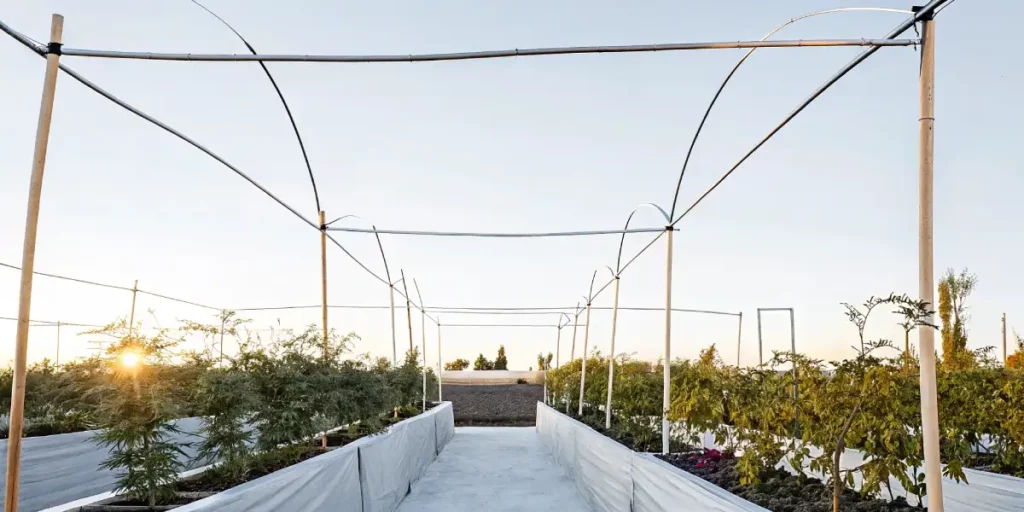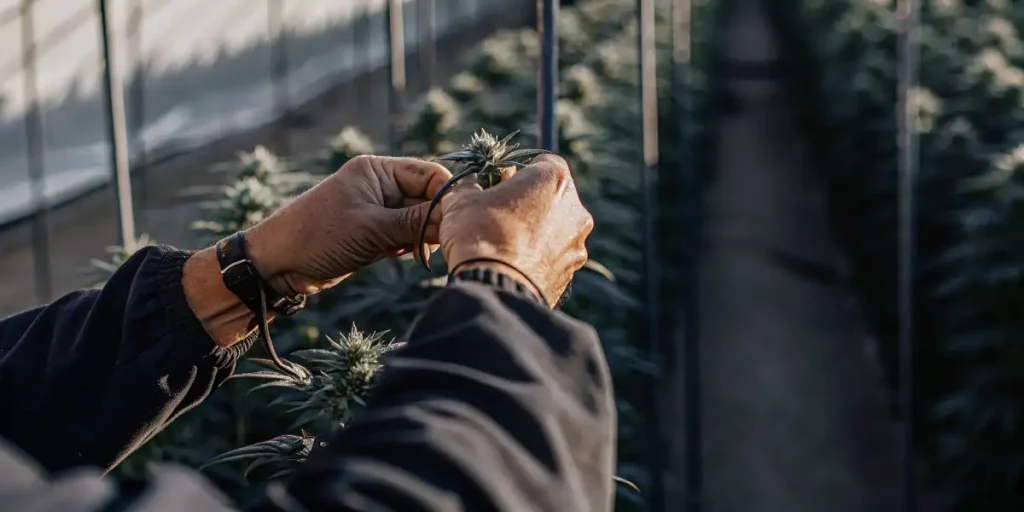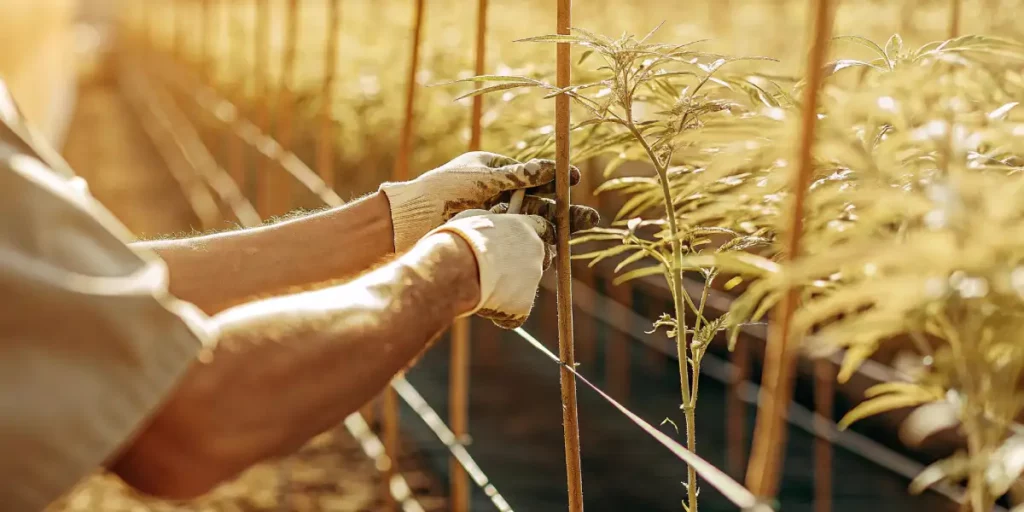Low stress training (LST) is a gentle way to guide your autoflower cannabis plants to grow wider instead of taller. This technique opens up more of the plant to light, boosting growth without causing harm. It’s especially useful for autoflowers, which have a short lifecycle. LST helps you make the most out of every growing day. By bending branches and tying them down, you expose more buds to light, leading to bigger yields.
For first-time growers, LST may sound a bit complex, but it’s actually quite simple. Think of it as gently nudging your plant to grow the way you want. The best low stress training techniques for autoflower include bending the main stem and tying it down with soft ties. This encourages the side branches to grow up and get more light. The result? More buds and a higher yield.
Real-life growers swear by LST for autoflowers. Take the case of a grower using the Blueberry Auto from Global Green Genetics. By applying LST, they saw a significant increase in the number of bud sites, resulting in a much-improved yield. This simple training turned an average grow into an exceptional one.
The flexibility of low stress training autoflower techniques is that they can be adapted to different growing environments, whether indoors or outdoors. Regardless of the setting, the principle remains the same: encourage horizontal growth to maximize light exposure. This adaptability is part of what makes LST a favored method among growers of all levels.
Moreover, low stress training autoflower can be particularly beneficial in stealth grows due to its ability to keep plants compact. By controlling the plant’s height and shape, you can maintain a low profile and still achieve high yields. This can be especially advantageous in urban growing environments where discretion is key.
Low Stress Training Autoflower Step by Step Guide
To start, choose a young plant, ideally in its early vegetative stage. This is when the plant is most flexible and can handle bending without breaking. Begin by gently bending the main stem sideways. Secure it with a soft tie, ensuring it stays in place without cutting into the stem. A popular choice is using soft garden wire or even pipe cleaners.
As the plant grows, continue to adjust the ties. This ensures that new growth remains exposed to light. Keep in mind that the goal is to maintain an even canopy, where all parts of the plant get equal light exposure. This results in more uniform growth and more buds.
When implementing a low stress training autoflower step by step guide, consistency is crucial. Regularly check the ties and adjust them as the plant grows to prevent any part from becoming too dominant. This balanced approach ensures that all branches receive adequate light, contributing to a robust and bountiful harvest.
It’s also important to monitor the plant’s response to training. If a branch appears stressed or damaged, make adjustments to alleviate pressure. The best low stress training techniques for autoflower involve a gentle touch and attentiveness to the plant’s needs, fostering a healthy and productive growth environment.

Benefits of Low Stress Training Autoflower Plants
One of the biggest benefits of low stress training autoflower plants is the control it gives you over your grow space. Without LST, autoflowers tend to grow tall and slender, which can be problematic if you have limited vertical space. LST allows you to keep plants compact and bushy, maximizing your grow area.
Another advantage is improved light penetration. By spreading out the plant, more light reaches the lower branches. This can lead to an increase in bud size and density. A grower using the Northern Lights Auto from Global Green Genetics reported that their buds were not only more plentiful but also heavier after using LST.
Additionally, low stress training autoflower plants can lead to better nutrient distribution. By creating an even canopy, nutrients are more effectively transported throughout the plant. This not only enhances overall growth but also ensures that each bud site receives the necessary resources for optimal development.
Moreover, LST can make watering and maintenance easier. With a more open structure, accessing different parts of the plant is simplified, allowing for more efficient care. This ease of maintenance is one of the understated benefits of low stress training autoflower plants, contributing to healthier and more manageable grows.
Low Stress Training Autoflower Yield Improvement
Increasing yield is a top priority for many growers, and LST is a proven method to achieve this. By manipulating the plant’s shape, you encourage more bud sites. More bud sites mean more flowers, and more flowers mean a bigger harvest. It’s a simple concept with profound results.
For instance, using the White Widow Auto from Global Green Genetics, growers have reported yields of up to 30% more than plants that were not trained. This dramatic increase is due to the enhanced light exposure and the plant’s ability to focus energy on producing flowers rather than stretching upwards.
Low stress training autoflower yield improvement is not just about quantity, but also quality. By ensuring that all parts of the plant receive ample light, LST helps in producing denser and more resinous buds. This leads to a superior final product that is both potent and flavorful.
Furthermore, LST can help in achieving a more predictable harvest. By controlling the plant’s shape and size, growers can better estimate yields and plan their growing cycles accordingly. This predictability is an invaluable aspect of low stress training autoflower techniques for both personal and commercial growers.
Low Stress Training Autoflower Growing Tips
Start early. The earlier you begin LST, the more time your plant has to adapt and grow in the desired shape. This maximizes the benefits you’ll see in your final harvest. Just remember to be gentle; autoflowers are more delicate than their photoperiod counterparts.
Use the right tools. Soft ties, such as garden wire or pipe cleaners, are essential. They allow you to secure your plant without causing damage. Also, keep an eye on the ties as the plant grows. You don’t want them to become too tight and cut into the stem.
Another important low stress training autoflower growing tip is to maintain a consistent light schedule. Autoflowers thrive on a steady light cycle, which complements the effects of LST. Consistent lighting ensures that the plant continues to grow vigorously and respond well to training.
Additionally, keep your growing environment clean and free from pests. This reduces stress on the plant and supports the benefits of low stress training autoflower techniques. Regularly inspect your plants and immediately address any signs of pests or disease to maintain a healthy grow room.

Frequently Asked Questions
How long should I continue low stress training on my autoflower?
You should continue low stress training until your plant stops stretching, typically around the third or fourth week of flowering. This is when autoflowers naturally stop growing taller and focus energy on bud production. Regular adjustments during this period ensure that all parts of the plant receive adequate light.
Stopping LST too early may result in uneven growth and reduced light exposure for lower bud sites. However, be cautious not to over-stress the plant, as excessive bending can hinder development. A balanced approach will yield the best results.
It’s important to adapt your low stress training autoflower strategy based on the plant’s individual growth patterns. Some strains may require longer periods of training, while others might reach their optimal structure sooner. Observing your plants closely will help you determine the best time to cease LST.
Remember, the goal of low stress training autoflower practices is to optimize light exposure and bud production without causing undue stress. Balancing the duration and intensity of training will lead to a more successful and rewarding harvest.
Can I combine low stress training with other techniques?
Yes, combining LST with other techniques like topping or defoliation can enhance your results. Topping can create multiple main colas, while defoliation improves airflow and light penetration. However, with autoflowers, you must be cautious. They have a limited growth period, so avoid excessive stress.
Many growers find success with a gentle approach. For example, topping once and then using LST can be effective. Always monitor your plant’s reaction and adjust your methods accordingly. Global Green Genetics strains like Blueberry Auto are particularly responsive to these combined techniques.
When integrating low stress training autoflower techniques with others, always prioritize the plant’s health. Start with small, incremental changes to gauge the plant’s response. This ensures that you do not overwhelm the plant and allows you to refine your approach for maximum yield improvement.
Combining techniques can lead to a more diverse and robust canopy, but it’s important to maintain harmony in your methods. The best low stress training techniques for autoflower involve a careful balance of different methods to achieve optimal results.
What is the best time to start low stress training on autoflowers?
The best time to start low stress training is during the early vegetative stage. This is when the plant is growing rapidly but is still flexible enough to handle bending. Waiting too long can result in a thicker, less pliable stem, making LST more challenging.
Starting early maximizes the benefits, as it allows the plant to develop a wide, even canopy. Keep in mind that every strain grows differently, so observe your plants closely. Strains from Global Green Genetics, like Northern Lights Auto, show excellent results when LST is applied early.
Early implementation of low stress training autoflower techniques sets the foundation for a successful grow cycle. By starting at the right time, you encourage robust growth patterns that lead to more efficient light absorption and higher yields.
Another reason to start early is to allow the plant ample time to recover from any minor stress. This recovery period ensures that the plant remains healthy and vigorous throughout its lifecycle, ultimately enhancing both the quality and quantity of the harvest.
Will low stress training affect the quality of my buds?
Low stress training can improve bud quality by ensuring even light distribution and promoting healthier growth. When more parts of the plant receive optimal light, the buds can grow larger and denser. This often results in a higher-quality harvest with more potent and flavorful buds.
Quality is also influenced by the plant’s overall health. By reducing stress and enhancing airflow, LST helps maintain vigor and resilience against diseases. This holistic approach benefits both the quantity and quality of your harvest.
Moreover, low stress training autoflower techniques can lead to buds with enhanced resin production. The even distribution of light encourages the plant to produce more trichomes, which are responsible for the potency and aroma of the buds.
With proper execution, LST not only boosts yield but also enhances the overall appeal of the buds. This improvement in bud quality is a significant advantage for growers seeking to produce top-tier cannabis.
Can low stress training help with pest control?
While LST is not a direct method of pest control, it does help by improving airflow and reducing the likelihood of pest infestations. By spreading the plant out, you minimize dense areas where pests might hide. This makes it easier to spot and address any issues early on.
Good airflow also creates an environment less conducive to pests and mold. Regularly inspecting your plants during LST can catch potential problems before they escalate. This proactive approach keeps your garden healthy and productive.
Besides to its direct benefits, low stress training autoflower practices contribute to a holistic growing environment. By maintaining a well-ventilated canopy, you reduce humidity levels, further discouraging the development of mold and mildew.
By incorporating LST into your growing regimen, you support an environment where natural deterrents to pests are enhanced. This makes low stress training autoflower techniques a valuable part of an integrated pest management strategy.

